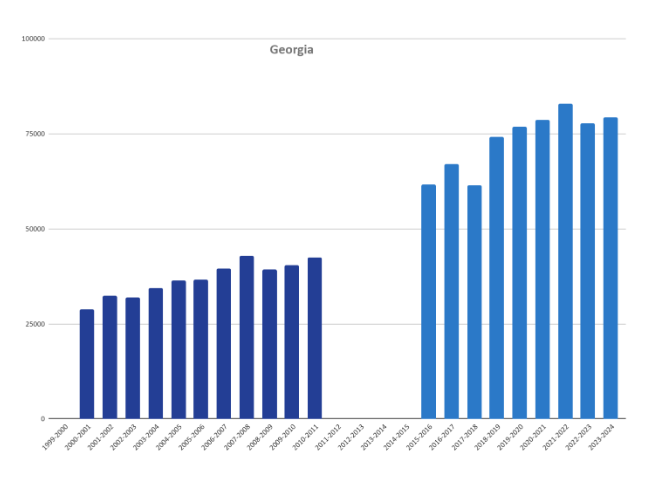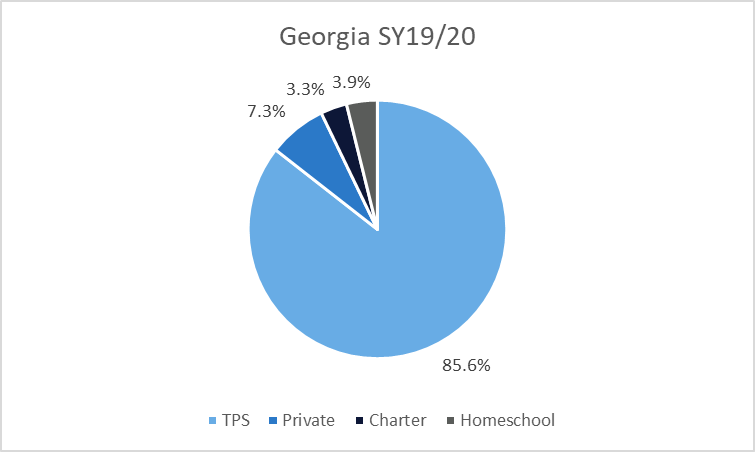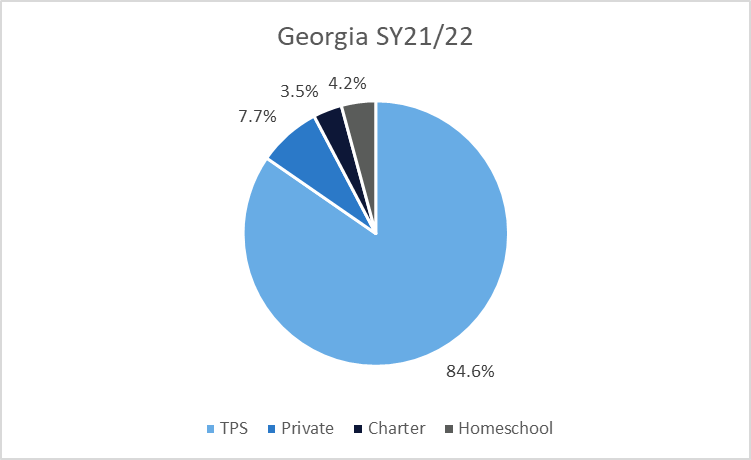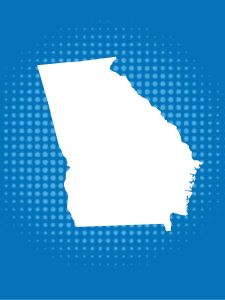Georgia requires a nationally norm-referenced test for homeschool participants but not for the state’s publicly schooled students. Some states with testing requirements offer their homeschool families a free state test, but in Georgia’s case, the state test does not meet the minimum test requirement in place for homeschool participation.
History
Georgia, located in the southern United States, legalized homeschooling in 1984. The number of homeschooled students has steadily increased over the past 20 years.
Regulation
Georgia parents who choose to educate their children, ages 6-16, at home must file a declaration of intent form that includes student names, ages, and addresses. Further, it appears that some annual information is required. The state offers one option for homeschooling. Daily attendance forms are no longer required, but the school year should include 180 days and a certain number of daily hours. Similarly, Georgia has subject requirements. For example, instruction must include math, English language arts, science, social studies, and reading (O.C.G.A. § 20-2-690).
There are minimum educator requirements, and parents in Georgia may also hire a tutor for their child’s home instruction. Instruction providers must have a high school diploma or the equivalent.
Homeschool students must take a “nationally standardized test,” in certain years, beginning in third grade. Public school students take the state test, the Georgia Milestones, which is not a nationally standardized test and therefore does not meet the homeschool requirement. It is, however, what all public school students are assessed with each year in the state. Nevertheless, homeschool parents must adhere to the higher standard, contact testing providers, or work with a local homeschool association for assistance in procuring and administering the required test.
Generally, Georgia nonpublic students do not have access to the offerings at their local public schools. This means that they cannot take courses, play sports, or participate in clubs or other educational activities. There are a couple of exceptions. Homeschooled students in grades 6-12 may be able to access extracurricular offerings under some circumstances, such as part-time public school enrollment. Funding is available for students who meet specific requirements under the Dexter Mosely Act. Further, high school students can access dual enrollment courses for free, with some requirements. Students with special needs qualify for the same services as students in private schools (O.C.G.A.§20-2-690; O.C.G.A. §20-2-159).
State Data
In 2001, Georgia reported nearly 32,000 homeschooled students. Growing steadily, by 2019, Georgia had 74,000 registered homeschooled students. At the height of the pandemic, there were over 80,000 homeschooled students in Georgia. Data are missing from 2011 to 2014.

Compared to the U.S. Census estimates of 7.1% of families in the spring of 2020 and 16.0% by the fall, these estimates are reasonable given the actual participation information in the chart. The national estimates during this time were 5.4% and 11.1%, respectively. Based on U.S. Census data, our calculations indicate that about 6.99% of K-12 students in Georgia were homeschooled during the 2022-23 school year, and 6.27% during the 2023-24 school year. Due to survey changes, the data from 2020 reflects the percentage of households, while the data from following years reflects the percentage of students.
Georgia is one of a few states that provides participation information by subgroups upon request. Currently, those data include a breakout of participation by district.
Cross-Sector Comparison
During the 2019-20 academic year, 3.9% of Georgia’s K-12 students were homeschooled. Almost twice as many students attended private schools, at 7.3%. In contrast, the percentage of Georgia students attending charter schools was slightly less than homeschool participation, at only 3.3%. In 2021-22, 4.2% of Georgia’s K-12 students were homeschooled. Almost twice as many students attended private schools, at 7.7%. In contrast, the percentage of Georgia students attending charter schools was slightly less than homeschool participation, at only 3.5%.


School Choice Context
In addition to homeschooling, parents in Georgia have various educational choices available. These options include traditional public schools with inter- and intra-district options, vouchers, and tax credit scholarships, charter schools, magnet schools, and virtual learning programs. There do not appear to be any funding options for traditional homeschool families. It is unclear if students in microschools, homeschool co-ops, or hybrid homeschools might qualify for the Qualified Education Expense Tax Credit scholarship.
Commentary
Georgia does not publicly report the collected homeschool participation data, but will provide data upon request, including disaggregated data by district. To improve transparency, Georgia should consider publicly reporting the data collected, including the disaggregated information on student participation by age/grade.
Further, access for all students to the state’s educational opportunities could improve by permitting all nonpublic students to participate in public school offerings, such as art classes, sports, and other courses. Many states across the country allow nonpublic students to participate in classes and extracurricular activities. A student’s age and funding should not pose barriers to participation.
Currently, homeschoolers must take a nationally norm-referenced test, which means that the scores are compared to other students in the country. Georgia’s state test is not nationally normed, which could mean it only compares student scores within the state. Holding homeschooled students to a higher standard on test requirements should be addressed.

-
16.0% Families
Around 16.0% of families in Georgia homeschooled during the height of the pandemic (Fall 2020).
-
1984 Legalized
Homeschooling was legalized in 1984 in the state of Georgia.
-

-
More Information
16.0% Families
Around 16.0% of families in Georgia homeschooled during the height of the pandemic (Fall 2020).
1984 Legalized
Homeschooling was legalized in 1984 in the state of Georgia.

More Information
Last updated March 2025.